Mask sealed, fins up, snorkel in place. There’s an art to catching green sea turtles, and you’ve got to be in position, gear adjusted, ready to go.
Newly minted tracker David Cerna is perched on the bow of a flat-bottomed motor boat, eyes trained on the turtle all of the boat’s occupants are watching, arms extended, index fingers pointing to keep it in sight and help the marine biologist at the tiller follow its movements.
When the moment is right, Cerna slides off the bow into shallow water with an awkward splash and emerges with a sizable turtle, flippers flapping.
Cheers erupt from the boat. Success!
Another endangered green sea turtle’s data – shell and head dimensions, weight, defining characteristics – will soon be logged, and the turtle will be tagged and released back into Savannah Sound, an almost impossibly aqua-colored, juvenile green sea turtle habitat off the Bahamian island of Eleuthera.
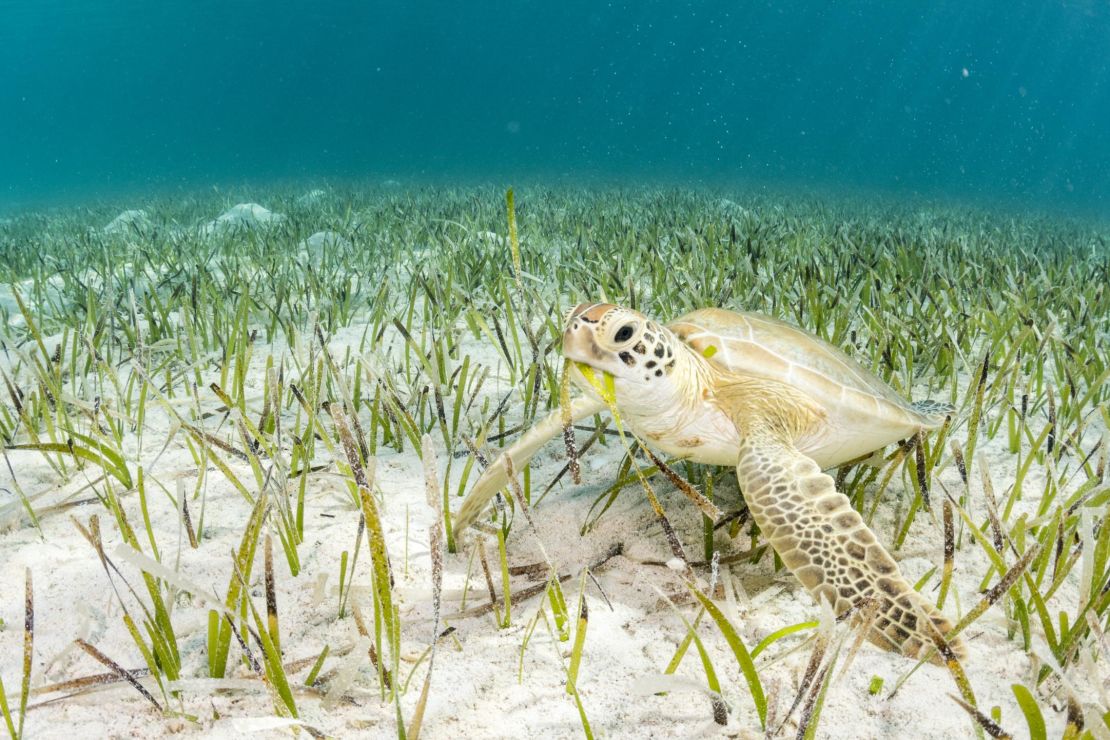
At the boat’s tiller is Annabelle Brooks, the lead scientist for Earthwatch Institute’s sea turtle tracking expedition in the Bahamas. Earthwatch is an environmental charity that has been pairing adventurous volunteers with scientific research projects across the globe for nearly a half century.
Cerna, 31, is one of eight volunteers in this group, and while he’s clearly up to the challenge, it’s his soon-to-be bride, Kathryn Eckert, who has a longstanding love affair with sea turtles. And that’s part of what Cerna loves about her.
“She is so excited when she finally gets to catch them, and she’ll just have them on the sand where we’re measuring them and she’ll just be sweet talking them, and … I’m like, ‘you little weirdo,’ but it’s cute. It’s really cute,” Cerna said.
The nine-day Earthwatch expedition is excitement enough, but this couple will cap their stay on Eleuthera by getting married on the beach. The pair, who live in Tampa, Florida, wanted to do the sea turtle trip together, and their plans to elope aligned perfectly with the dreamy Bahamas location.
“It’s fun to have something that both of us can share and that especially before we get married to give back to something that’s greater than us. It’s just wonderful,” Eckert said.
Thrill of the chase
Catching green sea turtles is no easy feat. For one, they’re fast.
“They’re faster than you can swim, for sure,” said Cerna. “Turtles are 100% faster than us,” Eckert added with a laugh.
“They’re a lot lighter in the water and once you lift them out of the water, they’re super heavy. And they’re slippery, so it’s difficult,” said Eckert, who was nearing her 30th birthday at the time.
And sometimes, swimming with them is distracting.
“The best is when they’re right below you and you’re swimming over top of them. And it’s just like you and the turtle are swimming together,” Eckert said.
And you don’t want that magic to end, “But then you think, ‘OK, Annabelle needs our help with this research … so I need to catch you now.’ “
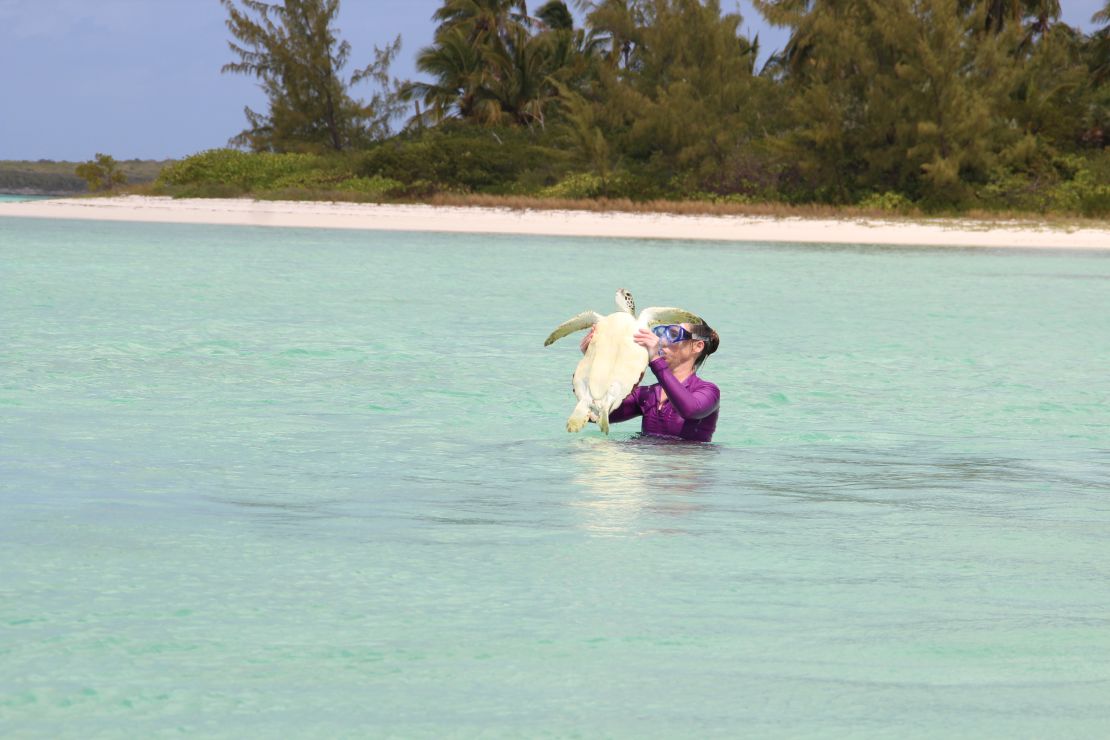
The group is typically split, with four volunteers on the boat with Brooks and the rest on the beach ready to help work up the turtles they catch.
Sometimes it takes four people to catch a single turtle. One person may swim like crazy without catching up to the one they’re after, so Brooks cues the next person to hop in and pick up where the last volunteer left off.
“So you’ve just got to always be ready for those turtles,” Cerna said. “And you’ve got to be ready in the water and ready in the boat and do our best to just work as a team to catch them.”
Back on the beach, data is recorded during a quick workup that involves measuring each turtle – its shell (or carapace), its head, its weight – taking pictures to record the turtle’s distinctive shell and face markings and tagging it so that data can be compared if the same turtle is caught again.
Working for a cause
The Bahamas’ shallow mangrove creeks and sea grass pastures act as nurseries for juvenile green sea turtles that arrive here after spending their first few years in deep ocean waters.
The young turtles may spend 10 to 15 years foraging in these shallow spots before heading back to deeper water and ultimately to the nesting grounds where they were born – in areas ranging from the southeastern United States to the north coast of South America and the west coast of Africa, according to Brooks, the lead scientist.
Green sea turtles are an endangered species, so protecting the important juvenile habitats in the Bahamas helps protect populations in all of those areas, said Brooks, who is a PhD candidate at the University of Exeter.
Brooks is in her sixth year working with Earthwatch and hosts eight to 10 Bahamas turtle tracking expeditions each year.
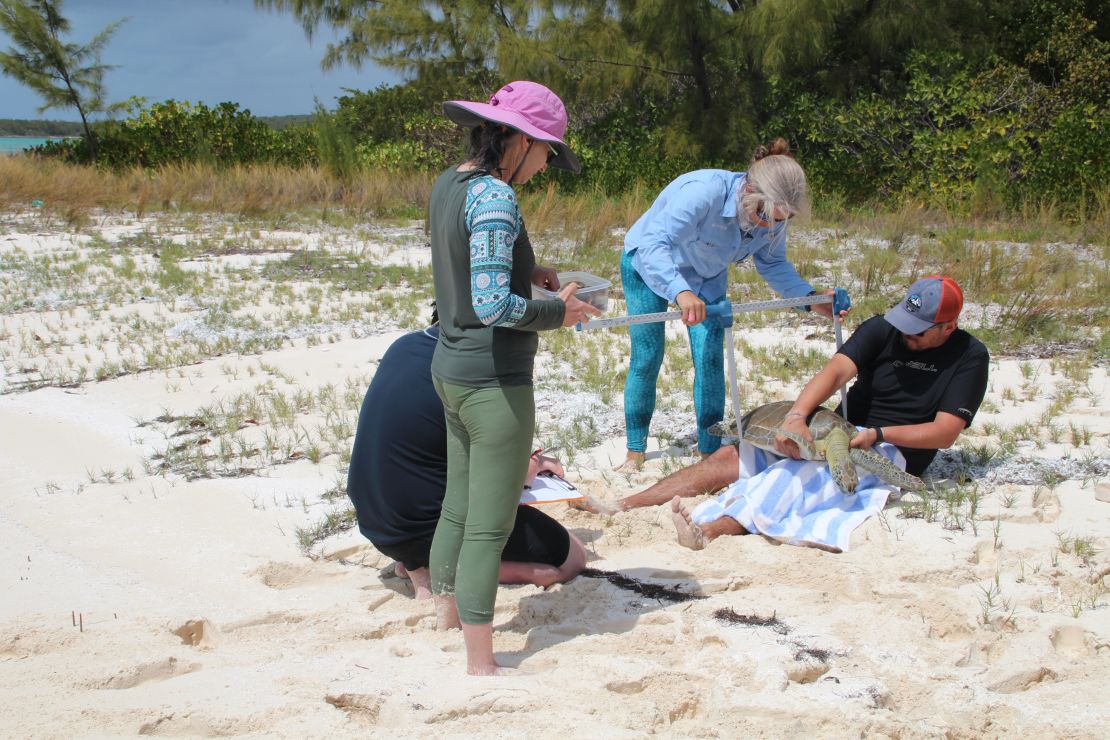
This particular group of volunteers, ranging in age from 22 to 81, caught a total of 32 turtles during their stay in March. The data they gathered will help reveal what factors influence juvenile green sea turtle habitat selection and hopefully inform decisions about areas that should be protected.
The health of green sea turtles in specific areas is also tracked and growth-rate information is gleaned from recapturing turtles.
But beyond the scientific data, the expeditions raise awareness that can be passed along to others.
The volunteers “make a connection with that animal and with nature as well,” Brooks said. “And that’s really important for us as humans to have connection with nature because that’s the only way we’re going to really care about what happens to it,” she said.
Working for the good of the planet is Earthwatch’s mission, and the organization has loyal followers.
One of this group’s volunteers, 81-year-old Allyn Schneider, has participated in 11 expeditions, from Mongolia to Brazil’s Pantanal. Two of the group’s volunteers were helping with Brooks’ research for a second time.
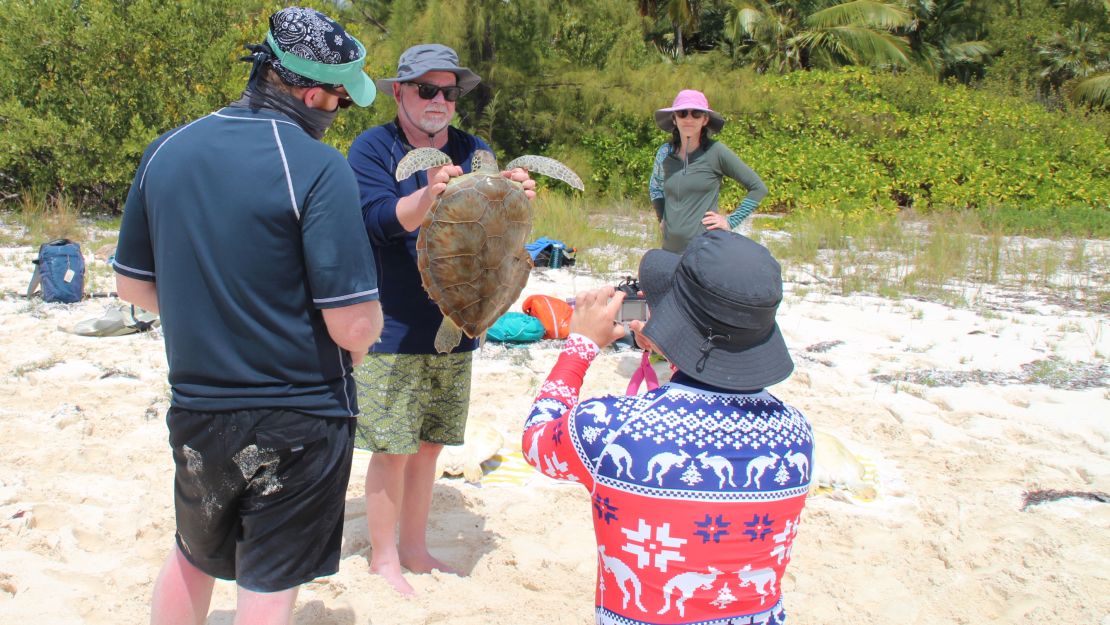
Cycle of life
Every trip has its highs and lows.
Phil, a turtle named after Eckert’s father, was the darling of the expedition’s second-to-last day of field work. Weighing in at just 2.7 kilos (about 6 pounds) with a straight carapace length of 26.2 centimeters (about 10 inches), Phil was the smallest green sea turtle the group caught.
Everyone cooed over Phil, but the cycle of life soon dealt a collective gut-punch to the group.
Of the six turtles captured on their final day on Savannah Sound, five had fibropapillomatosis, or FP.
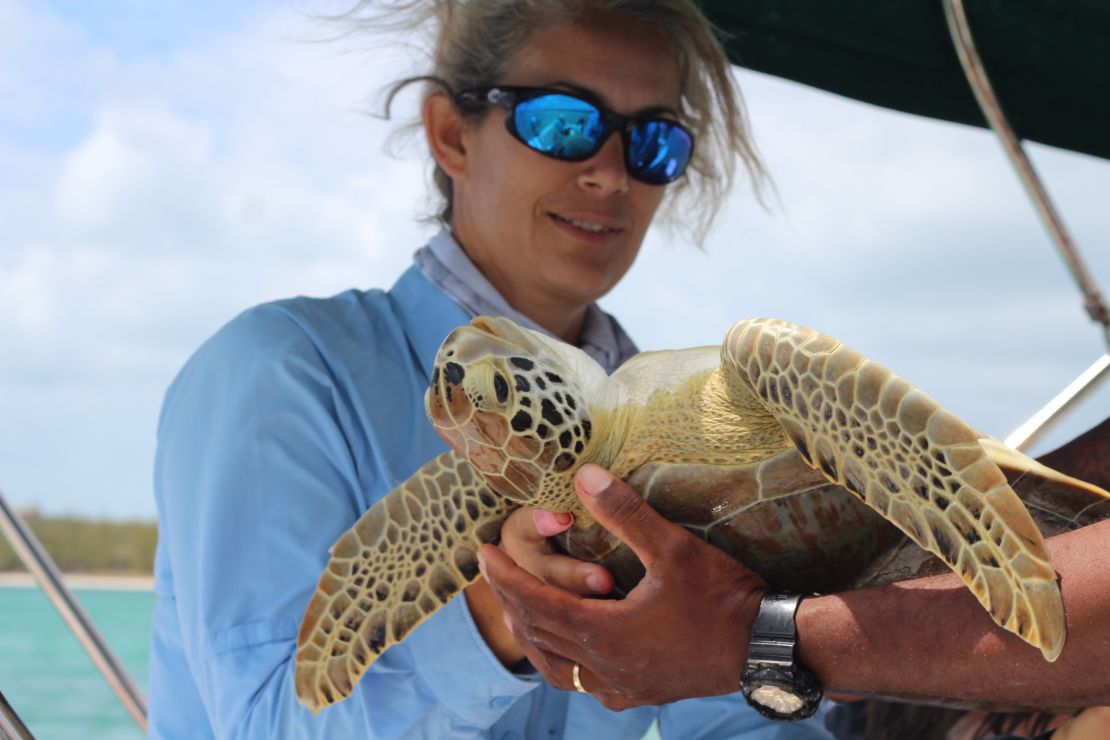
First observed in Eleuthera in 2018, turtles with FP develop debilitating tumors that can grow so large that they affect mobility, vision and feeding. Brooks is looking for clues about how the disease might be spreading and any factors that contribute to it.
Josh Moyer, a visiting biologist who was helping Brooks coordinate the expedition, caught a turtle with a particularly severe case of FP. The turtle, Savannah, was missing a flipper and had extensive tumors over its eyes and extremities. Its body was concave from a lack of nutrition.
Moyer, who is a PhD candidate at the University of Massachusetts Amherst, said he’s trained to be objective, but he was visibly shaken by the turtle’s condition, even as he pointed out that illness and death are part of the natural turnover.
“Something about that turtle hit me right here,” Moyer said, pointing to his heart.
He wasn’t the only one distressed by the state of the sea turtles caught that day. The mood was somber as the volunteers gathered data and released the turtles.
Yet the heart-wrenching finale was a reminder of the work’s value.
“You see little turtles like little Phil, and you keep going to keep those guys healthy,” Cerna said.
His sadness was a sharp contrast to the joy he and a radiant Eckert exuded two days later when they said their vows on the beach in front of elegant boutique resort La Bougainvillea.
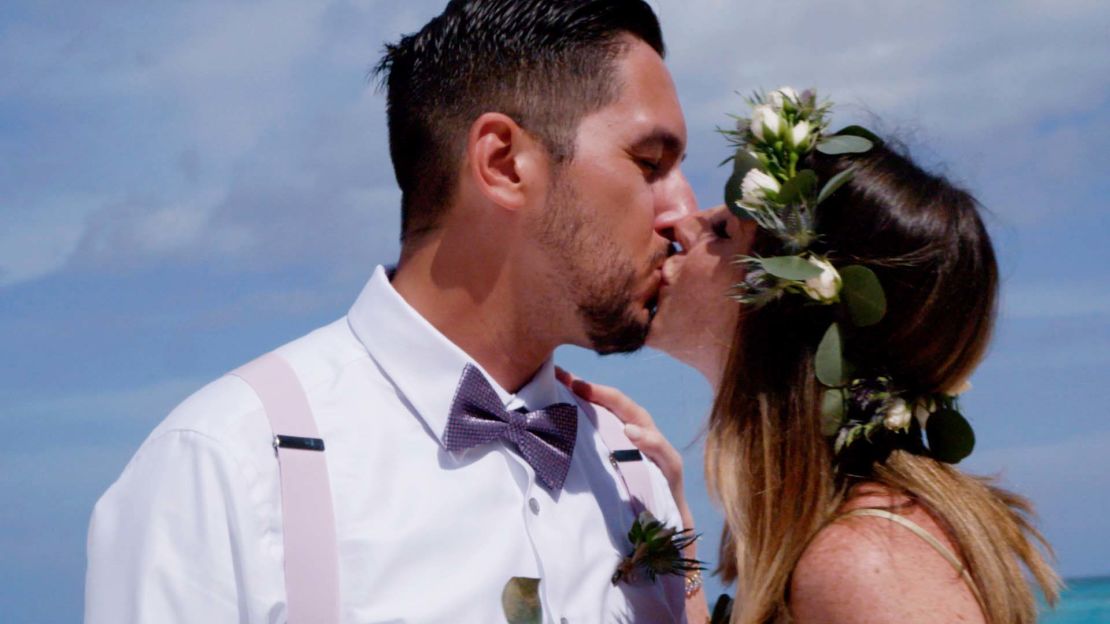
The ceremony – with just an officiant and a few witnesses – took place next to a sign reading, “Welcome to our beginning.”
It was a beginning marked with attempts to preserve something irreplaceable.
“We want our kids to see the sea turtles someday,” Cerna said. “Hopefully, we’re just trying to do our part as much as we can to help make sure that happens.”
If you go
Earthwatch’s Tracking Sea Turtles in the Bahamas expedition costs $2,950 per person. The cost includes accommodations, food, local transportation, medical and emergency evacuation insurance, as well as a contribution to the research itself. There’s a Facebook page related to the project. Earthwatch has 40 research expeditions around the world, with multiple trips per project.
Local partner Fishbone Tours provides expedition assistance. The company offers a range of tailored tours – from snorkeling to bone fishing – with Captain Julius Rankine.
Eckert and Cerna were married at La Bougainvillea, an intimate boutique resort with a showstopping infinity pool and beach bar located on a pink sand beach on Eleuthera’s Atlantic coast. Spring rates for ocean view rooms start at $300.



















